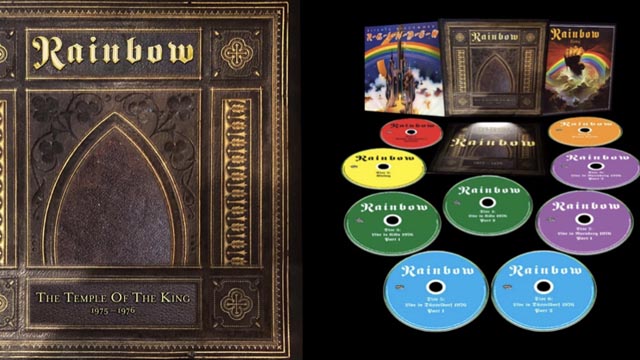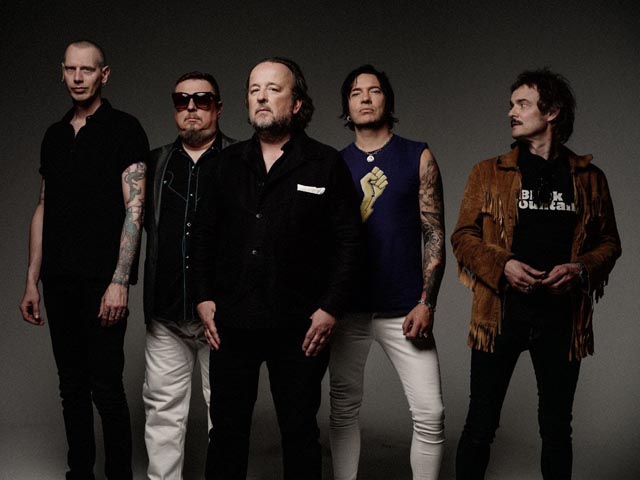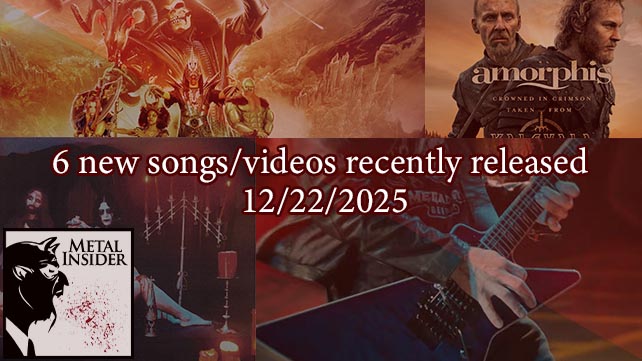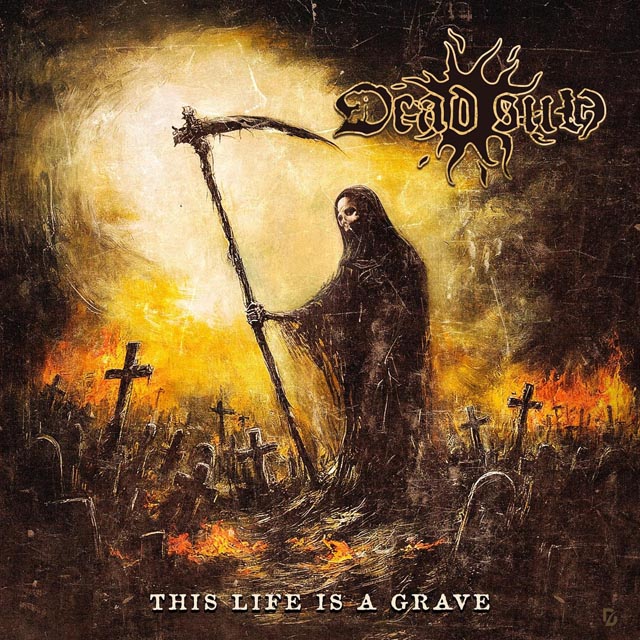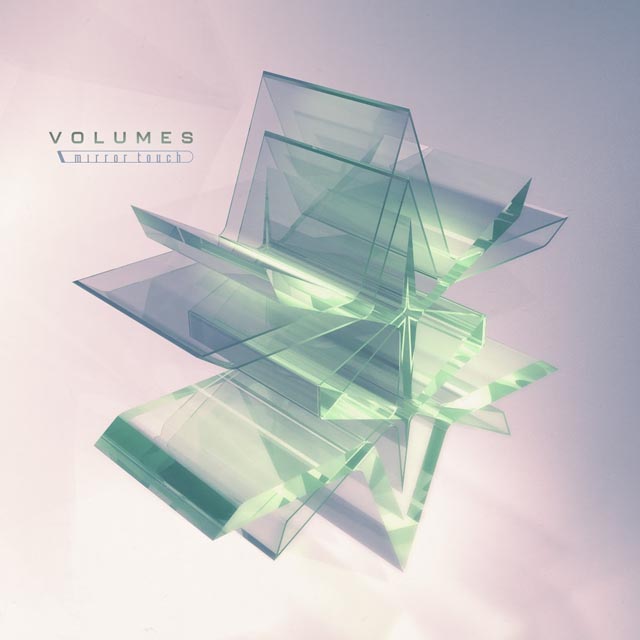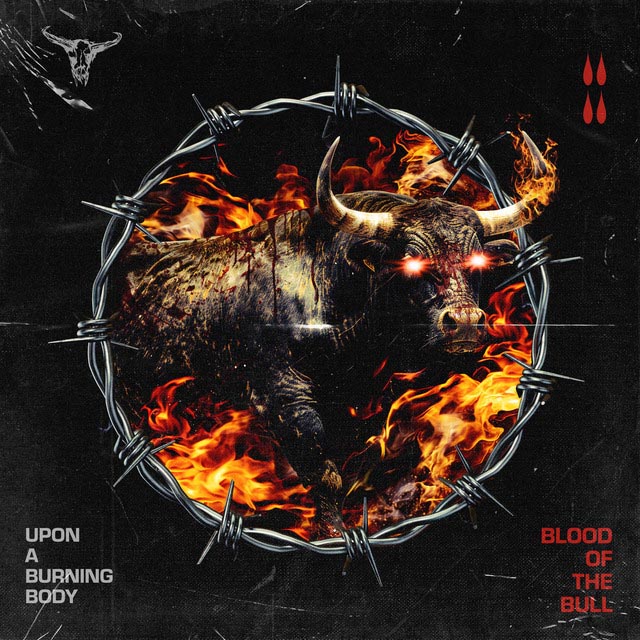 Mike Semesky is no stranger to the life of a career musician. The frontman of Danish titans Raunchy has a musical resume that would inspire shock and awe in seasoned veterans twice his age. Semesky has recently added to that impressive resume with Fugue, the debut album from his progressive side project Rest Among Ruins. We debuted the track “In Another’s Skin” a few weeks ago as a small taste of the greatness to come. With Fugue hitting stores earlier this week, Semesky sat down with us to talk about the inspiration behind his latest project, what’s going on in the Raunchy camp, the multitude of other work he has lined up, and writing more concept albums than we can keep track of.
Mike Semesky is no stranger to the life of a career musician. The frontman of Danish titans Raunchy has a musical resume that would inspire shock and awe in seasoned veterans twice his age. Semesky has recently added to that impressive resume with Fugue, the debut album from his progressive side project Rest Among Ruins. We debuted the track “In Another’s Skin” a few weeks ago as a small taste of the greatness to come. With Fugue hitting stores earlier this week, Semesky sat down with us to talk about the inspiration behind his latest project, what’s going on in the Raunchy camp, the multitude of other work he has lined up, and writing more concept albums than we can keep track of.
Let’s start out with Rest Among Ruins. This project has a great story behind it. Tell me about what brought it into being.
Believe it or not, Rest Among Ruins came to be in 2008. We did play some live shows, and it used to be a full-fledged band. We did do some touring – this was back in MySpace days. We’re talking top friends lists, let’s look up the promoters in these different states. We did that whole thing for a few years, and it was all while I was in school studying clinical psychology. You’ll see how that came into play when I get into the concept later. So while we were playing originally and doing all that, I was writing Fugue back then. I sang on the album, and played guitar and bass, so this thing is very much my baby. It’s been like giving birth, and it’s like I’ve been pregnant for five years.
So how did your studies factor into the concept of the album?
While I was studying psychology, I had an amazing opportunity to work at a psychiatric hospital. I was stationed on a crisis stabilization unit for male adolescent teens, mainly 13 to 18-year-olds coming in with their first psychotic episode, manic episode, depressive episode; a lot of people came in suicidal. There was a lot of focus on med stabilization, especially since insurance these days is only paying for a week, two weeks tops in really severe cases. Short-term treatment is all that people are getting these days, unfortunately. Every once in a while, though, I would get assigned to another unit. There was one day when I went into work and was assigned to the trauma disorders unit. One of my professors in the honors college at Towson University was doing research on that unit, and there was a fascinating case in a client there that I got to meet. There was a patient who had a very rare dissociative disorder. The more well-known dissociative disorder is the one that used to be called “multiple identity disorder”, and was later changed to dissociative identity disorder. With dissociative fugue, your mind just takes on a completely different identity. The power of the mind is insane. These people are creating new memories for themselves, moving, and creating a whole new life and identity for themselves. This was a very rare case of that. This man had not been himself for five-plus years and left everyone that knew him. Obviously I don’t go into specific details on the album, mainly because I want to be poetic, but also because of doctor-patient confidentiality and all that. But it was just such a fascinating story, and reading through his medical records and having conversations about these dream sequences that were going on while he was in and out of consciousness, it was really inspiring. I’m very much a visual learner, so when I was communicating with clients back then, I was always trying to put myself in their shoes and empathize and picture what their reality looks like through their eyes. It was such a profound opportunity to work with this gentleman, just because the picture and the imagery that I had in my head of everything that was going on in his head was just very surreal. A part of my writing process lyrically is going in with a blank canvas and just painting what I see on that canvas lyrically. That’s the approach that I took writing this, and it just somehow turned into Fugue.
There are a lot of metal bands that portray the mental and physical state of humanity like a horror film. Rest Among Ruins takes a different approach to that, taking something tragic and turning it into a surreal and somewhat beautiful story. Was that a goal you had for the album, trying to twist the perception?
Yeah, in a way. It was so abstract, and I’d never written lyrics like that before. I seem to have this obsession with writing concept albums/ They channel my creative juices, and since I have a bunch of projects, writing concept albums seems to provide some structure for my awful ADD personality. (laughs) I’d never really written lyrics in abstract form like this, where I was going in and out of dream sequences and consciousness for one, but also out of order. There is a linear storyline in there, and if you actually have the album booklet, I have a little code that I sort of embedded at the very end of the lyrics. I just wrote the number of every song in order of the storyline. I don’t know if anyone’s going to pick up on it. I’ll be glad if anyone does, but that is the order of the storyline. But the track listing itself is a mish-mash of the sequence of things. I also just like the fact that I tried my best to write it in an ambiguous way so that it could be left up for interpretation. But it would be nice to see if anyone was able to put the puzzle together and rearrange the tracks, read the lyrics in order, and things like that.
One of the tracks that you recently debuted, “Reach the Edge”, features a guest vocalist, Aleka Farha. What was it like working with her, and how did you create her role in the album?
Aleka is phenomenal. She’s a raw, natural talent. I actually went to high school with her. I didn’t know her then, because I went to a pretty big high school. I didn’t know her until after I graduated. I’m pretty sure that she actually got in touch with me after I released my first cover on my YouTube channel. She just messaged me on Facebook and said, “Hey, I didn’t know you sing! I’m a singer myself and I’m trying to release some music. I’d love to get your opinion on a track if you don’t mind.” She sent me something, and I went in with zero expectations. It was this Frank Sinatra cover, and it was unbelievable. At that point, it just clicked right away. I knew I needed to collaborate with her. Our first vocal collaboration was this Florence & The Machine cover that we did for a tribute album that Sumerian Records put out almost exactly a year ago. I think it was May 13th of last year. She really didn’t have any experience with singing over metal. The Florence cover that we did was an acoustic version of that Florence song, so it definitely was nowhere close to what she did on “Reach the Edge”. But when I asked her if she wanted to be part of the album, she was really excited about it. She came in, learned the lyrics and melodies on the spot, and just killed it. It was amazing. Her background is mainly in pop, R&B, and musical theater, but she came in and just killed it, like she was doing it for years. I was impressed.
That’s a crazy transition, because it sounds perfectly natural, as if she’d been singing rock and metal all along.
Exactly, and I’m so happy that people feel the same way. I read another review of our album, and they compared that song to something like Amaranthe or Nightwish. I thought it was so cool for her to get some recognition and be compared to some of those acts.
What about your bandmates, Ben Schmitz and Geoff Palmer? How did they get involved in the project? Have they been with you since the beginning?
Geoff has been with the band since the beginning. Ben came on board maybe two years in. He replaced another guitar player we had. But he’s a phenomenal guitar player. My younger brother is also a vocalist, and he was in a band with Ben in high school. He ended up joining us when we first started recording Fugue.
If you guys were going to do any live shows, how would you fit in the rest of the instruments? I know you played rhythm guitar and bass on the album.
I guess it would depend on the timing. Ideally, we would hire fill-ins for rhythm guitar and bass. There’s no guarantee that we’re going to be doing live performances, but if there was an offer that we couldn’t turn down, and the timeline required us to be prepared quickly, I’d imagine we’d do something like my last band Intervals did, and we’d just have bass on a track or something like that, and just get a rhythm guitar player. Just something to make the process of getting live a little bit easier.
Do you have any other ideas or storylines for future Rest Among Ruins albums already in your head?
Not yet. I haven’t started writing lyrics for anything new from Rest Among Ruins yet. We chose to release this album independently. Luckily that allows us to put out music on our own terms, and I know that I’m already feeling inspired to start writing new material soon. I don’t have any concepts in mind, nothing specific. But it’s gonna happen. I’d imagine that next year, I’ll start getting into the groove of writing more Rest Among Ruins material with the guys.
Switching gears now, what’s going on with Raunchy right now?
I’m heading over to Europe in less than a month, and we’re playing the biggest metal festival in Denmark, Copenhell. It’s going to be awesome! Slipknot is playing, Gojira is playing. The Darkness is apparently still a band, so that’s gonna be a good time. I’m not sure if they still believe in a thing called love, but I’m hoping they do! (laughs) It’s going to be great to share the stage with so many bands that I’ve been listening to for such a long time. I think there’s talks of a European tour after that. We did a short headline run to support the new album in April, and that was really fun getting to play a lot of new material. I love performing the old songs, because I grew up on them and I just love them. But it’s a lot easier, as you can imagine, to play something that I wrote. So it just came so much more naturally. But there are talks of a European tour in the fall, and I think we’ll start writing after that. I got a sample of some concept art from Lars, our guitar player. He’s a graphic designer, and he designed the Vices.Virtues.Visions. album artwork. He’s really good with visuals, and he’s very unique. He intentionally doesn’t use Photoshop at all for this, because he thinks the Photoshop thing is overdone, and it looks too polished and too clean. I really like what he came up with. It’s literally just an illustration, like what he did for Vices and what he’s going to be doing for the next album. I’m really excited. I’m sure it’s going to be another concept album, so I’m really looking forward to writing that.
Is there any chance of fitting a US tour in there somewhere?
I really hope so! Those guys have been dying to come to the States. Unfortunately, our booking agency and our management is Europe and everywhere east of that. We’ve played pretty much everywhere except for North America. I think it’s just a matter of the offer being right. I’m the youngest guy in the group. Two of the guys have families, and one just got married. Comfort is a big thing – I don’t think they’re trying to come over here and tour in a tiny van. They’re used to nicer accommodations from touring in Europe where their following is bigger.
It’s definitely a big change for a band that has a larger following in Europe, going from headlining there, to touring in America and being the opening act.
It really is. Touring in Europe is so much different than touring the States, in terms of the venues and just the way you’re treated, honestly. You can expect lunch when you get there, and a home-cooked meal for dinner. Whereas touring in the States, you’re in a van, depending on your budget. I’m sure there are plenty of bands touring in buses and whatnot, but in this genre, for the most part, you’re in a van, and you can’t really expect too much from the venues. It’s just different. I don’t mean to talk shit about any venues in the States, but it’s just different than touring in Europe. I just feel like there’s much more of an appreciation for the arts over there.
You mentioned growing up on the older Raunchy material. You came into the band two years ago with a very different vocal style from both of the previous vocalists, Kasper Thomsen and Lars Vognstrup. Was it a big adjustment learning the older songs and adapting your voice to them?
Yeah, it was an adjustment, especially not having written those lyrics. Kasper has a very unique style, and getting used to the types of rhythms that he used and adapting to his style was a bit of a challenge. But because I’d been a fan for so long, it came fairly easily, just in the sense that I had a pretty good idea of what the lyrics were, and they’re such a singalong band. The songs are so catchy that it’s hard not to pick up on that stuff. Also, I don’t know if you know Kasper’s other band, The Arcane Order. They’re working on a new album. Their guitar player, Flemming, is a really good friend of ours. I just wanted to give him a shoutout. He did a guest solo on Vices, I think on “I, Avarice”. He also filled in on my first tour with Raunchy ever, before Vices came out. He filled in on that tour, and he’s very much a part of the Raunchy family.
What would you say has been the most challenging thing for you since joining Raunchy, in terms of adapting to a new band?
Honestly, they have made the transition so smooth for me. They gave me full creative freedom over the lyrics and melodies when we were writing the album. They’re such down-to-earth guys. The fact that they all started out as a group of friends and grew up together, it’s just such a different dynamic than what I’m used to. I’ve only been in international bands among the touring bands I’ve been in. It’s been a group of people that don’t really know each other getting mashed together and hoping that everyone gets along. That’s how it was with The HAARP Machine, being a UK band, and that’s how it was in Intervals. I feel so lucky, not only to be in a band that I’ve been in love with for so long, but the fact that I came into a group of down-to-earth, friendly, and hilarious guys. They really treated me well from the beginning, and we clicked instantly. I’m very fortunate for that.
You also came into the band at a time where the metal scene seems to be shifting towards Raunchy’s style, using some of the pop elements and the mixture of sounds.
Yeah, definitely!
As a vocalist, how do you manage the range of screams that you have, which includes some extreme highs and lows?
When I first started singing, I was self-taught, which is not the best idea. I learned a lot of really bad tendencies by teaching myself. I eventually pursued classical training, and I did that for a few years, followed by rock training. Now I actually am a vocal coach. I do online Skype lessons with fans from around the world, varying levels from beginner to advanced level vocalists. I’m helping people with the tendencies that I used to deal with, because that service wasn’t necessarily available when I first started singing. I love being part of the up-and-coming talent. It’s so inspiring! But to answer your question, the lower growls are some of the first things that I learned when I was teaching myself how to do the aggressive vocals. From the beginning, I actually was doing that correctly. I’m really careful with my chords. I go to an EMT once a year to get a laryngoscopy done to make sure everything is good with my vocal chords, just out of precaution. My chords are totally good, and I’ve been screaming for years now, so it’s good to know that I didn’t do any damage and that I was actually approaching the growls with the right technique.
So other than doing Rest Among Ruins and Raunchy, what else is on your plate right now?
It’s kind of crazy how the timing worked out, but next up, I have another studio band, Ordinance. It’s a melodic death metal group with Alex Rudinger from The Faceless. He was the drummer in The HAARP Machine too, and we’ve been playing in bands together since he was about 14. He’s from Maryland as well, and we’ve known each other from the music scene for a long time. He’s one of my best friends. But anyway, we’ve both been in multiple bands since we started Ordinance back in 2010. We self-released an album in 2011, and after that, he joined Threat Signal and I joined The HAARP Machine. Then he quit Threat Signal, I got him into The HAARP Machine, and then he went to The Faceless and I went to Intervals. It was a crazy sequence of events! But all the while, we were still working on this Ordinance album. It’s a studio band, and Greg, our guitar player, had been touring as a bassist with Jeff Loomis. We were working on this album while we were all on the road still, but it’s finally coming together now. The same guy that mixed The HAARP Machine’s album is mixing this Ordinance album, and it’s sounding huge. I’m really excited for it. Believe it or not, it’s a concept album! (laughs)
How many concept albums can a guy write in one year? It seems like we might find out with you!
Right? Anyway, it’s fifteen tracks. I am really proud of these lyrics and the concept. I think it will turn some heads, and I’m really excited for people to hear this. It’s in the final stages of mixing now, so we’ll probably be releasing a song in the next few months. I’m keeping busy with all of this, and vocal training with my students. I’m very fortunate that I can do that online and take that on the road with me. Eventually, I’ll also get to my solo stuff. I’m working on some solo music that’s more along the lines of indie, similar to the stuff I cover on YouTube. One day, I’ll have some solo material out. I’m spread a little thin right now, but it’s all really fun and exciting work that I love, so it’s worth it!
Fugue is out now, and is available through BandCamp, iTunes, and Amazon.







